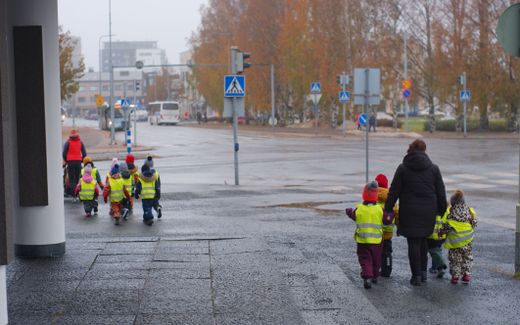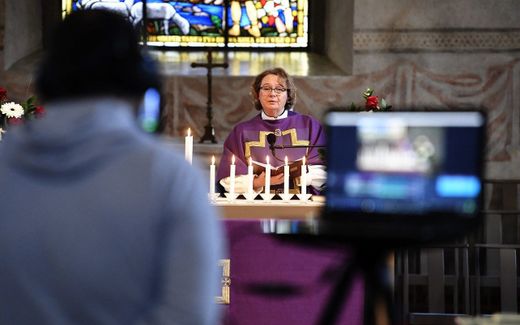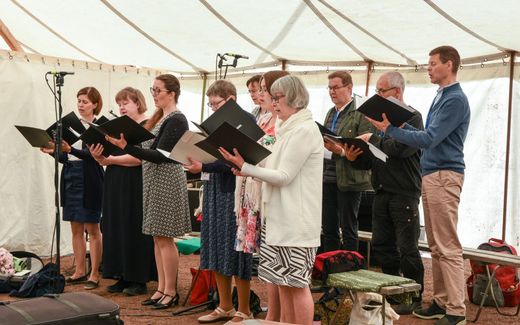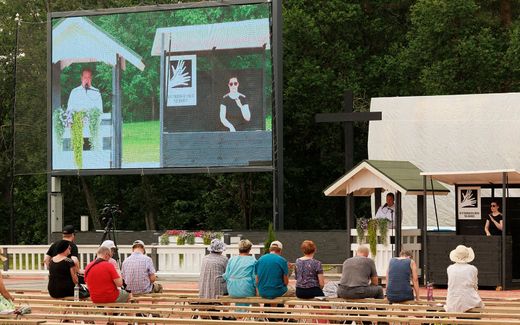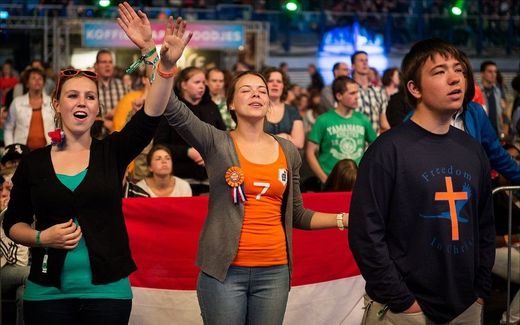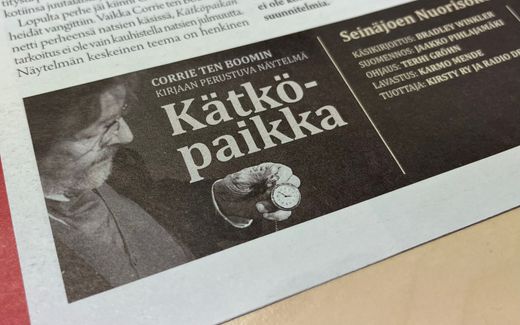Biblebelt feature: Prayer opened a fountain for hard-working Fins (1/2)
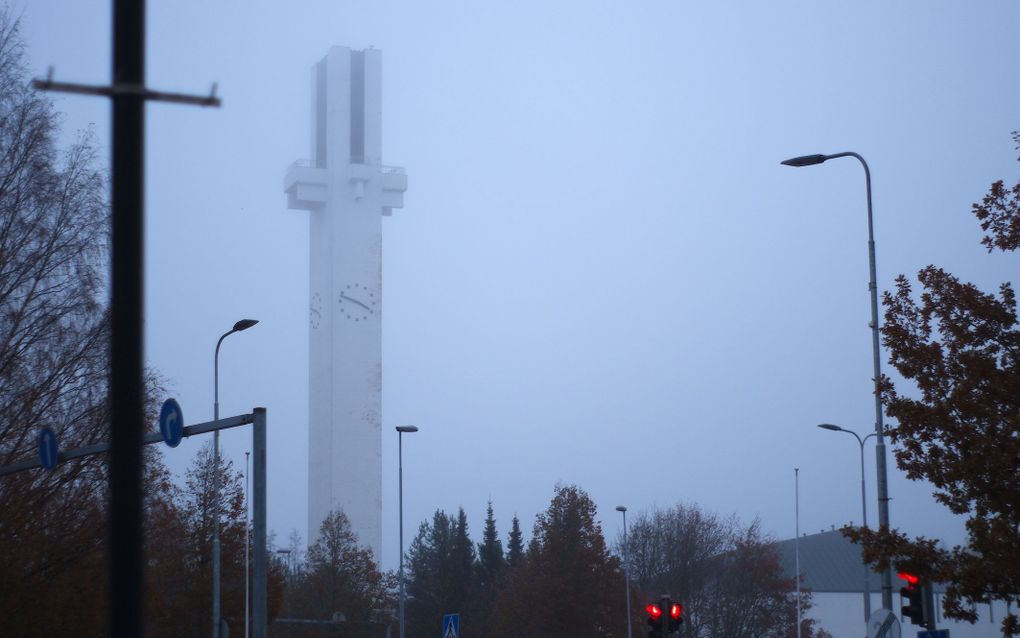
Church under the cross. The Finnish architect Alvar Aalto gave Seinäjoki a bell-tower in the form of a cross. Photo CNE, Evert van Vlastuin
Christian Life
Working hard exists; the Biblebelt in Finland is famous for it. People there also have reverence for God and respect for parents. Those are some fruits of God’s work in various revivals in the coastal region on the Gulf of Bothnia.
Seinäjoki wakes up in a thawing world. Last week’s snow piles are still next to the road, but today, it is foggy and drizzly. At the railway station, morning light falls on the monument, depicting Seinäjoki (pronounced Sénajokki) grew at a crossroads of (railway) roads in the Ostrobothnia region.
Part 1 of a series of European Biblebelts
The town only came to prosper in the 1960s. It never grew larger than 65,000 inhabitants. There are no tall buildings in Seinäjoki. There is plenty of space between fields and pine forests in the middle of Finland.
The Pentecostal church meets in a building in a park just outside town. The church’s construction around 2000 was accompanied by an intense prayer for God’s Spirit. “That did something,” says assistant pastor Jacob Huttunen. “From then on, we have had a weekly thanksgiving meeting on Wednesday evenings. We will continue that tradition because we cannot organise a revival ourselves. Besides, a revival never comes without prayer.”
Principal pastor Markku Tuppurainen nods. He pulls up his sleeve and shows a tattoo. “For various offences, I was imprisoned for seven years. In the late 1970s, a revival came to the prison. With 30 prisoners and 10 guards, I came to Christ. I was baptised accompanied by three guards, as they were afraid I would escape. But the whole atmosphere in the prison had changed. Prisoners and guards started praying together.”
After his release in 1984, he gave himself to preaching the gospel. Among other places, he served in the capital town of Helsinki. “That differs from here as black and white. I feel more respect for God here. The values of the Bible live here. For example, there is reverence for parents.”
A little further towards the centre is the Free Church of Seinäjoki. This congregation originated in the late nineteenth century from the spiritual needs of some women. The flag of the State of Israel has been on the stage at the Evangelical congregation for many years.
The twentieth century also saw several revivals in the small town. Not always spectacular, but noticeable. “People come under awareness of sin and seek forgiveness. That is the key,” says Jaakko Pihlajamäki. He grew up in the area. “There are testimonies of revivals in the 1950s, the 1970s and the 1990s.”
In the new building, one of the halls is occupied by a childcare centre. The dream is for a Christian primary school to grow out of it, a new phenomenon in Finland’s Biblebelt.
Pastor Ari Urhonen previously worked in other regions of Finland, including on the Russian border. “The big difference is that people here are very straightforward. But it does take longer to gain their trust.”
Urhonen does not want to glamorise the Biblebelt. “Divorce is also on the rise here, despite the great work of Marriage Camps in this region. Alcohol addiction may be less here, but when it comes to drugs, Seinäjoki ranks poorly. That’s why we need a new revival. And we also need inner renewal as congregational leadership.”
Fountain
The Pentecostal church in Seinäjoki came into being in 1935. Nineteen women and three men began praying for a spiritual awakening. “They prayed for an opened fountain of God’s presence. The humour is that the congregation’s first pastor was called Lähde; that means fountain,” says Tuppurainen, pointing to the pastor’s portrait on the wall.
Church attendance on Sunday has never been that important in Finland, says the bishop of the Lutheran Church in the region, Matti Salomäki. “Even in Ostrobothnia, it is not very high; think about 1 per cent of members. However, the percentage of church members among the population is higher here than in the rest of Finland: 73 per cent compared to 65 per cent. In our diocese, that amounts to 392,000 people. On Sundays, of course, many people attend revival movement meetings or free churches.”

Even in the Pentecostal Church of Seinäjoki, church on Sunday morning is not the central occasion. “Out of 1,500 members, about 250 to 400 come,” says assistant pastor Jacob Huttunen. “During the week, we also have many activities. Every week, about a thousand people participate in an activity. But for us, it is important that they focus on Jesus Christ, not whether they participate in something.”
If mass church attendance does not characterise the Biblebelt, then what does? Urhonen smiles: “Hard work.”
Bishop Salomäki: “Patriotism and entrepreneurial spirit. Even in the smallest villages, you find small businesses. That shows a basic trust in life.”
An hour from Seinäjoki, in Vaasa, are the headquarters of the Swedish Lutheran Evangelical Association in Finland (SLEF). The association is rooted in a revival among Swedish-speaking Finns in the coastal region along the Gulf of Bothnia, says director Albert Häggblom. The group also has a Finnish-speaking branch. “The Lutheran pastor Fredrik Hedberg wrote a book on the Letter to the Ephesians, which worked like dynamite. People who had struggled with their guilt for years suddenly found certainty in the sacrifice of Christ.”
Hedberg’s book laid the foundation for a pietistic movement within the Evangelical Lutheran Church in Finland. There are five such revival movements within the church, Häggblom says. “All are rooted in a particular revival. Lutheran mission from Finland comes from these organisations. The church itself does not do mission.” Häggblom himself served for a time in Kenya.
Häggblom knows dozens of SLEF prayer houses in the Swedish-speaking region north of Vaasa. “These are little halls where people gather on Sundays for services or other times for prayer and Bible reading. Today, this is quite normal, but in the 19th century, prayer leaders were sometimes just imprisoned. The church wanted to suppress this, but people felt an urge to pray. This left a mark on whole villages and towns.”
Preaching in the revival movement still contains the same elements: repentance and forgiveness from a sense of impending eternity.
Today, relations with the Lutheran Church are once again under pressure, says Häggblom. “Many within the national state church want to force everyone to accept same-sex marriage. Most revival movements do not want that. Many reckon with a split between the revival movements and the Lutheran Church.”
The largest group among Swedish-speaking pietists in Finland are the Laestadians, formed from the work of Lars Levi Laestadius in the nineteenth century. Across Finland, Christians speak with wonder about massive summer camps of tens of thousands of participants. At the same time, this group is isolated. It hardly recognises other Christians as true believers.
Dr Gerd Snellman visits a prayer house near Jakobstad every week. She belongs to the LFF (Laestadian Peace Association). In 2011, she finished a PhD dissertation on women of the Laestadians. “Traditionally, we all lived very isolated. We never heard other pastors preach; we didn’t read other magazines. When I was a child, girls did not wear trousers, and we did not use make-up. Mothers from our community were mostly at home with their big families. Calls for a youth camp or women’s evening were turned down. Many things still went on as they did in 1860.”
The big change came after 2009, when an abuse scandal within the community was revealed. “That led to openness and renewal.” However, the branch of the Conservative Laestadians of the SRK movement remains closed as before.
In the two Laestadian movements (LFF and SRK), there is also the question of the future within the Lutheran Church. Snellman: “We do not accept women as pastors and hold on to the marriage of man and woman. The discussion on this will be exciting.”
In Seinäjoki, volunteers set up tables with food in the Pentecostal Church’s lobby. The congregation has a food bank five days a week, says assistant pastor Huttunen. “Some volunteers visit shops and factories to collect things,” he says. It meets a need. “Besides Finns, many Ukrainian refugees use it,” he says.
This kind of initiative marks the mentality of Ostrobothnia, says Bishop Salomäki. “The church wants to be a natural part of the community. And people are willing to participate in that actively.”
Further reading: interview with Seinäjoki city council member Aki Ruotsala: Many kids and few unemployed in Finnish ‘Texas’
Related Articles


